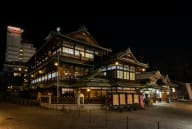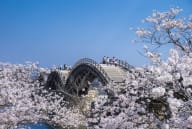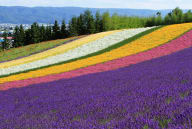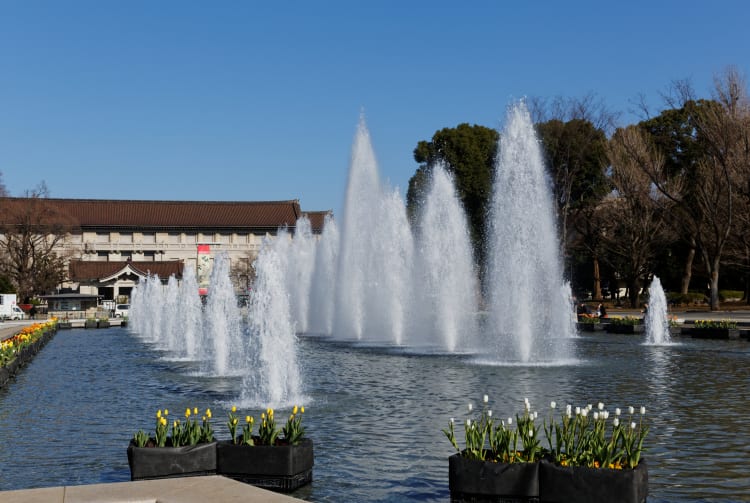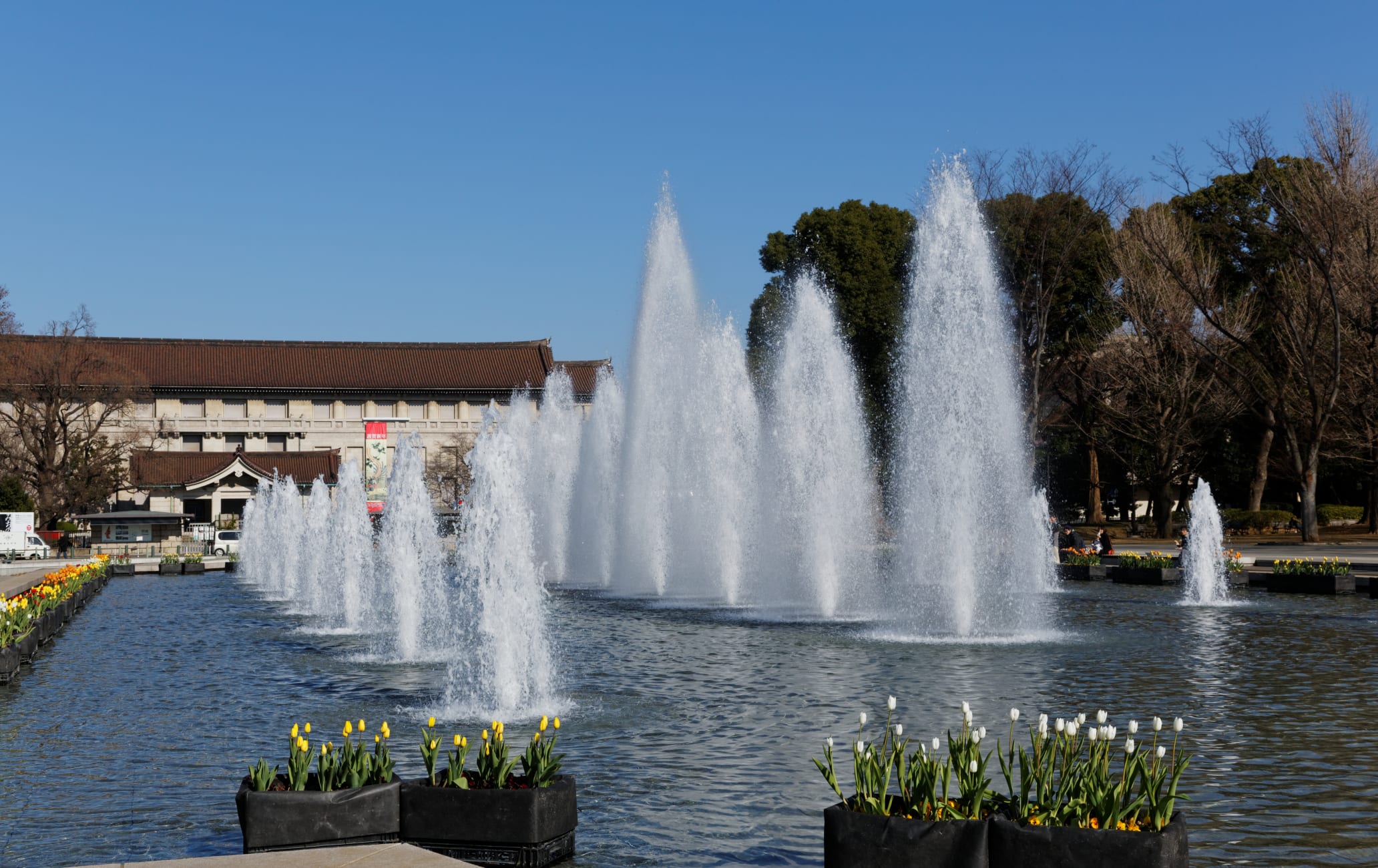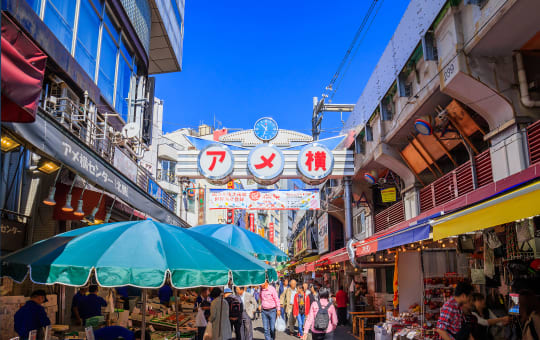Un parc historique, des temples, un grand zoo et des cerisiers en fleurs
Le parc d'Ueno est l'un des cinq plus vieux parcs publics du Japon. Il doit sa réputation au zoo d'Ueno, aux nombreux musées qu'il abrite et à ses spectaculaires cerisiers en fleurs au printemps. Ayant ouvert ses portes au public en 1873, le parc porte le nom officiel d'Ueno Onshi-Koen, signifiant « parc d'Ueno, cadeau impérial ».
À ne pas manquer
- Explorer les musées d'art, de sciences et d'histoire que le parc abrite
- Flâner le long de l'étang de Shinobazu et admirer le temple Bentendo
- Rendre visite à la statue de Saigo Takamori, « le dernier vrai samouraï »
Comment s'y rendre
Le parc d'Ueno est au carrefour de plusieurs lignes de train, de métro et de shinkansen.
La ligne circulaire JR Yamanote s'arrête à la gare d'Ueno, à quatre arrêts de la gare de Tokyo. Vous pouvez également rejoindre Ueno depuis l'aéroport de Narita grâce au Keisei Skyliner. Enfin, des trains à grande vitesse en provenance du nord et de la côte ouest du Japon s'arrêtent à Ueno.
La gare d'Ueno peut paraître labyrinthique, mais la sortie débouchant sur le parc d'Ueno est facile à trouver. Une fois cette sortie empruntée, vous verrez le parc juste en face de vous, de l'autre côté de la rue.

Les cerisiers en fleurs les plus célèbres de Tokyo
Si les excellents musées et galeries qui s'y trouvent, les pandas du zoo d'Ueno , l'étang de Shinobazu et le sanctuaire historique d'Ueno Toshogu sont autant de raisons de visiter le parc d'Ueno, l'endroit est surtout connu pour ses cerisiers en fleurs.
Les premiers arbres ont été plantés par Tokugawa Iemitsu (1604-1651), troisième dirigeant du shogunat Tokugawa. Aucun des cerisiers originaux n'a survécu plus de 400 ans depuis, mais la tradition consistant à observer les fleurs de sakura dans le parc continue encore aujourd'hui.
En effet, le parc d'Ueno accueille chaque printemps plus de deux millions de visiteurs venus admirer les sakura, dont la plupart remplissent l'allée principale du parc près de l'entrée du zoo d'Ueno . Cette zone regroupe environ la moitié des cerisiers en fleurs du parc. Au plus fort de l'animation, il faut s'y frayer un chemin à travers la foule de visiteurs profitant d'un pique-nique. Hanami est un événement printanier pendant lequel les gens mangent et boivent gaiement à l'ombre des fameuses fleurs blanches et roses.

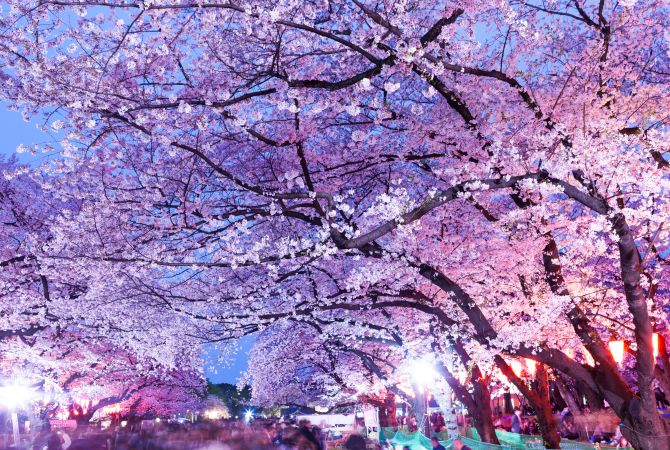
Des musées pour tous les goûts
Comprenant six musées, le parc d'Ueno est l'endroit rêvé pour en apprendre plus sur l'art et les sciences au Japon.
Centrés autour de l'art, de l'histoire, des sciences et plus encore, le musée de Shitamashi, le musée royal d'Ueno, le musée national de l'Art occidental , le musée national de la nature et des sciences , le musée national de Tokyo et le musée d'art métropolitain de Tokyo figurent parmi les plus grandes structures au monde.
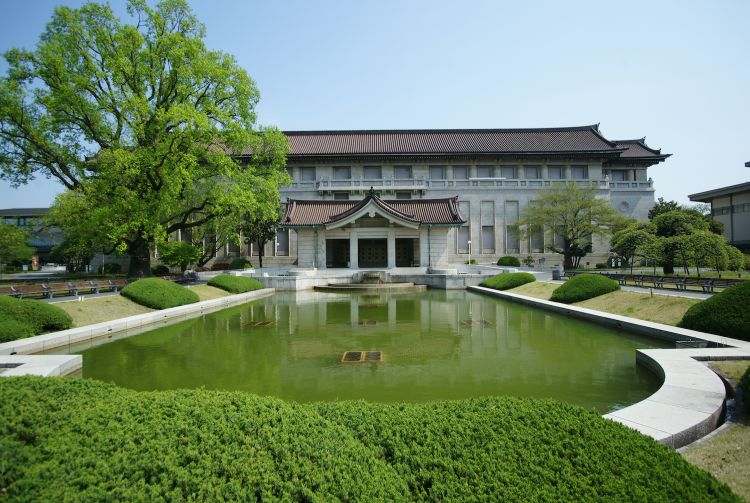
Le musée de Shitamachi, moins connu, mérite une visite si vous souhaitez en savoir plus sur l'histoire de Tokyo. Parfois oublié au profit des autres grands musées et galeries du parc d'Ueno, le musée de Shitamachi vous permettra d'imaginer la vie dans le Tokyo d'antan.
Shitamachi signifie littéralement « ville basse », ce qui, à Tokyo, se réfère aux plaines de l'est de la ville autour de la rivière Sumida. L'endroit n'était pas particulièrement pauvre mais son nom évoquait les artisans, pêcheurs, marins et commerçants qui y vivaient. Une visite de ce musée vous aidera non seulement à appréhender l'histoire de Tokyo, mais aussi à découvrir sa culture locale dont beaucoup d'éléments persistent aujourd'hui.

Des temples traditionnels et un étang bordé de fleurs de lotus
À deux pas du musée de Shitamachi se trouve l'étang de Shinobazu, un endroit incontournable du parc d'Ueno. Dans ses environs, vous pourrez découvrir les temples anciens du parc : Kan'ei-ji, dont le domaine est devenu le parc d'Ueno, le sanctuaire de Toshogu construit en l'honneur du shogun Tokugawa Ieyasu, et Kiyomizu Kannon-do, à l'architecture inspirée du célèbre temple de Kyoto.
Mais ce qui donne au lieu une atmosphère vraiment magique, presque sacrée, c'est la floraison chaque été de milliers de lotus sur l'étang Shinobazu. Au Japon, la fleur de lotus est depuis longtemps associée à la pureté, à la renaissance et au bouddhisme. Assurez-vous de ne pas manquer le spectacle des fleurs qui recouvrent complètement l'étang.
Le véritable « dernier samouraï »
Saigo Takamori fut l'un des samouraïs les plus célèbres et les plus influents du Japon, à la carrière pleine de rebondissements. Tout d'abord samouraï paysan à Kagoshima , il fut exilé deux fois, mena plusieurs guerres pour l'armée impériale, travailla en tant que politicien sous l'ère Meiji puis se donna la mort pendant la rébellion de Satsuma (1877). Il était tellement célèbre qu'après sa mort, des rumeurs coururent pendant de nombreuses années qu'il reviendrait un jour.
Takamori a été appelé « le dernier vrai samouraï » pour sa loyauté, son courage et son rôle de leader dans plusieurs batailles cruciales de l'histoire nippone. Il a joué un rôle majeur dans la restauration de Meiji qui a abouti à la modernisation et à l'occidentalisation du Japon. Sa statue de bronze présente dans le parc d'Ueno est l'une des plus célèbres du pays.
Découvertes aux alentours
Si l'attrait principal d'Ueno est sans aucun doute son parc et qu'il requiert dans l'idéal une journée entière d'exploration, vous pouvez combiner une visite plus courte avec d'autres attractions situées à proximité. À quelques pas, découvrez Ameya Yokocho . Plus connue sous le nom d'Ame-Yoko, cette rue était autrefois connue comme l'épicentre de la fabrication de bonbons à Tokyo et un lieu où étaient vendues les marchandises laissées par les forces d'occupation après la Seconde Guerre mondiale. Ce lieu reste un paradis pour les amateurs de bonnes affaires. Vous y trouverez également plusieurs petits restaurants en extérieur où vous pourrez déguster des kushi-katsu, des beignets de viande et des brochettes de légumes frites.
Plus loin dans la même direction qu'Ame-Yoko se trouve Akihabara . Autrefois réputée pour ses appareils électroménagers, la « ville électrique » de Tokyo a connu plusieurs mutations : un temps marché high-tech, elle est aujourd'hui devenue une véritable Mecque pour les amateurs d'anime, de manga, de jeux vidéo et de pop-culture en général. En allant du parc d'Ueno à Akihabara via Ame-Yoko (environ 1,2 km), on a peine croire qu'on se trouve dans la même ville — une belle preuve de l'échelle et de la diversité de Tokyo.



















